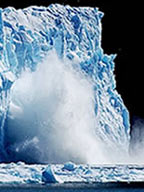
The world's Arctic regions have been covered by large
glaciers and ice caps, some hundreds of metres thick. The recent fast melting
ice has revealed surprises of life in times past. Melting ice and climate
change, however, pose potential problems for plant, animal and human life in all
parts of our world.
In Canada's high Arctic geologist James Bassinger recently uncovered tree trunks
more than 2 ½ metres wide and five metres long. These trees were 45 million
years old. Many of the nuts, seeds and cones were perfectly preserved.
Subsequent work revealed the existence of redwood swamp filled with royal ferns
downstream from groves of pine, spruce and walnut trees, indicating a climate
similar to Georgia USA. Even as late as 75,000 years ago fossil remains show the
existence of six foot tall beavers, scimitar cats, American camels and woolly
mammoths.
No scientist knows why the Arctic was so warm for so long previously or why it
cooled so fast wiping out the forests, the mammoths and giant beavers.
The continued melting of ice reservoirs, however will affect lives world wide.
Rising sea levels may displace over 100 million people. Glaciers hold 70 percent
of the world's fresh water. Changes in rainfall and temperature will affect crop
production. What to do? Yes, reduce carbon dioxide emissions and put plans in
place to adapt to potential challenges.
Equally important is the development of the spirit of will, courage, generosity,
thoughtfulness and respect, within ourselves and in humankind.